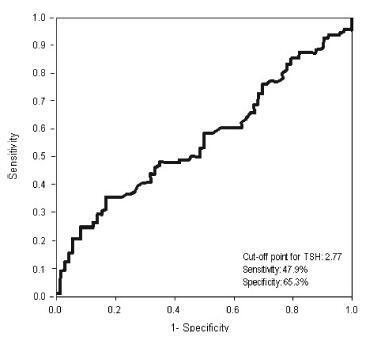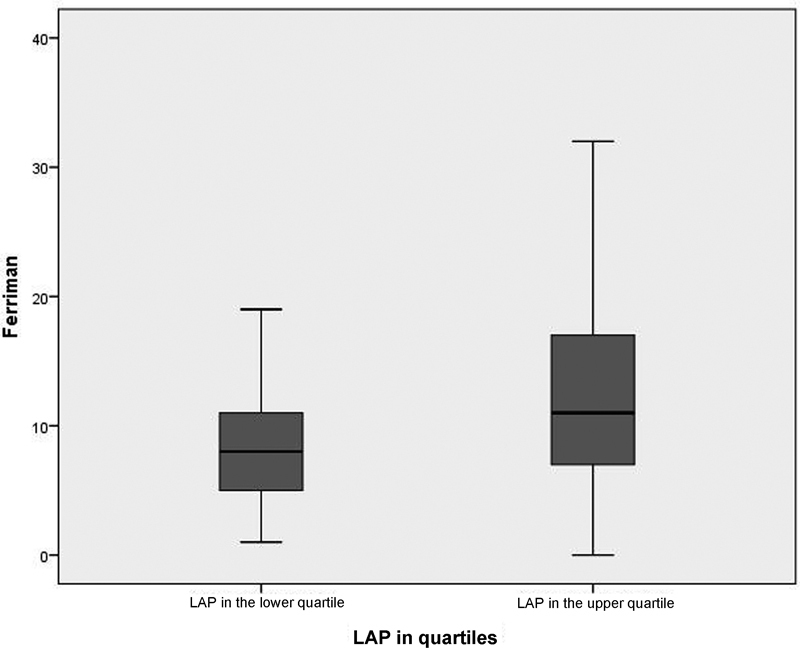-
Original Articles
Thyroid-stimulating Hormone and Insulin Resistance: Their Association with Polycystic Ovary Syndrome without Overt Hypothyroidism
Revista Brasileira de Ginecologia e Obstetrícia. 2017;39(5):224-228
05-01-2017
Summary
Original ArticlesThyroid-stimulating Hormone and Insulin Resistance: Their Association with Polycystic Ovary Syndrome without Overt Hypothyroidism
Revista Brasileira de Ginecologia e Obstetrícia. 2017;39(5):224-228
05-01-2017Views206Abstract
Objective
This study analyzed the effectiveness of the thyroid-stimulating hormone (TSH) as a predictor of insulin resistance (IR) and its association with the clinical and metabolic parameters of women with polycystic ovary syndrome (PCOS) without overt hypothyroidism.
Study Design
A cross-sectional study was performed. Women with PCOS and without overt hypothyroidism (n = 168) were included.
Methods
Receiver operating characteristic (ROC) curve was used to determine the cut-off point for TSH that would maximize sensitivity and specificity for a diagnosis of IR using homeostatic model assessment of insulin resistance (HOMA-IR)≥ 2.71. Clinical and metabolic parameters were compared as a function of the TSH cut-off limit and the presence of IR.
Results
Thyroid-stimulating hormone ≥ 2.77 mIU/L was associated with a diagnosis of IR, with sensitivity of 47.9% and specificity of 65.3%. There were no differences in clinical, hormonal or metabolic parameters between TSH < 2.77 and TSH of 2.77 - 10 mIU/L.
Conclusion
In women with PCOS without overt hypothyroidism, TSH ≥2.77 mIU/L is associated with IR; however, with poor sensibility, showing TSH to be a poor predictor of IR in this population. No clinical or metabolic alterations were found that would justify a change in clinical management. Thus, the IR should be investigated in all women with PCOS irrespective of TSH level.
Key-words dyslipidemiaHypothyroidismInsulin resistancePolycystic ovary syndromethyroid-stimulating hormoneSee more
-
Original Articles
Association between Lipid Accumulation Product and Hirsutism in Patients with Polycystic Ovary Syndrome
Revista Brasileira de Ginecologia e Obstetrícia. 2016;38(2):71-76
02-01-2016
Summary
Original ArticlesAssociation between Lipid Accumulation Product and Hirsutism in Patients with Polycystic Ovary Syndrome
Revista Brasileira de Ginecologia e Obstetrícia. 2016;38(2):71-76
02-01-2016Views155See moreObjective
Polycystic ovary syndrome (PCOS) is the most common endocrine metabolic disorder in women between menarche and menopause. Clinical hyperandrogenism is the most important diagnostic criterion of the syndrome, which manifests as hirsutism in 70% of cases. Hirsute carriers of PCOS have high cardiovascular risk. Lipid accumulation product (LAP) is an index for the evaluation of lipid accumulation in adults and the prediction of cardiovascular risk. The aim of this study was to evaluate the association between LAP and hirsutism in women with PCOS.
Methods
This was a cross-sectional observational study of a secondary database, which included 263 patients who had visited the Hyperandrogenism Outpatient Clinic from November 2009 to July 2014. The exclusion criteria were patients without Ferriman-Gallwey index (FGI) and/or LAP data. We used the Rotterdam criteria for the diagnosis of PCOS. All patients underwent medical assessment followed by measurement and recording of anthropometric data and the laboratory tests for measurement of the following: thyroid-stimulating hormone, follicle-stimulating hormone, prolactin, total testosterone, sex hormone binding globulin, 17-α-hydroxyprogesterone (follicular phase), glycohemoglobin A1c, and basal insulin. In addition, the subjects underwent lipid profiling and oral glucose tolerance tests. Other laboratory measurements were determined according to clinical criteria. LAP and the homeostatic model assessment index (HOMA-IR) were calculated using the data obtained. We divided patients into two groups: the PCOS group with normal LAP (< 34.5) and the PCOS group with altered LAP (> 34.5) to compare the occurrence of hirsutism. For statistical analysis, we used SPSS Statistics for Windows(r) and Microsoft Excel programs, with descriptive (frequencies, percentages, means, and standard deviations) and comparative analyses (Student's t-test and Chi-square test). We considered relations significant when the p-value was≤0.05.
Results
LAP was high in most patients (n = 177; 67.3%) and the FGI indicated that 58.5% of the patients (n = 154) had hirsutism. The analysis by LAP quartiles showed a positive correlation (p = 0.04) among patients with a high FGI and an upper quartile LAP (> 79.5) when compared with those with LAP < 29.0 (lower quartile).
Conclusion
This study demonstrated an association between high LAP and hirsutism. The FGI could represent a simple and low-cost tool to infer an increased cardiovascular risk in women with PCOS.

-
Artigos Originais
Quality of life and psychosocial aspects of polycystic ovary syndrome: a quali-quantitative approach
Revista Brasileira de Ginecologia e Obstetrícia. 2013;35(11):503-510
01-10-2013
Summary
Artigos OriginaisQuality of life and psychosocial aspects of polycystic ovary syndrome: a quali-quantitative approach
Revista Brasileira de Ginecologia e Obstetrícia. 2013;35(11):503-510
01-10-2013DOI 10.1590/S0100-72032013001100005
Views114See morePURPOSE: To evaluate the quality of life of women with polycystic ovary syndrome (POS) and to learn about the experience of these women regarding the symptoms of their disease. METHODS: The study complementarily employed two methodological approaches - quantitative and qualitative ones. The quality of life of 213 women was evaluated (quantitative approach) using the SF-36 questionnaire. Of these, 109 had POS (Case Group: 26.8±5.4 years of age) and 104 were healthy (Control Group: 23.9±6.7 years of age). Data were analyzed statistically by the Student t-test, the chi-square test and the Pearson correlation test, with the level of significance set at 5%. Fifteen women with POS participated in the quantitative study and were interviewed using a semi-structured questionnaire. The qualitative data were analyzed by the technique of categorical thematic analysis. RESULTS: The women with POS showed impaired quality of life compared to Control (functional capacity: 76.5±20.5 and 84.6±15.9, respectively; physical aspects 56.4±43.3 and 72.6±33.3; general health status: 55.2±21.0 and 62.5±17.2; vitality: 49.6±21.3 and 55.3±21.3; social aspects: 55.3±32.4 and 66.2±26.7; emotional aspects: 34.2±39.7 and 52.9±38.2; mental health: 50.6±22.8 and 59.2±20.2). Regarding the qualitative data, thematic categorical analysis revealed that feelings of "abnormality", sadness, fear and anxiety were associated with the main symptoms of POS, i.e., hirsutism, menstrual irregularity, infertility and obesity. These symptoms affected the social, professional and marital life of these women. CONCLUSION: POS compromises the quality of life of affected women, causing them to feel that they are different from other women. Thus, women with POS do not simply require medical treatment regarding the reproductive, aesthetic and metabolic effects of the disease, but also need multiprofessional care.
-
Artigos Originais
Metabolic profile in women of different body mass indices with polycystic ovary syndrome
Revista Brasileira de Ginecologia e Obstetrícia. 2013;35(9):413-420
11-06-2013
Summary
Artigos OriginaisMetabolic profile in women of different body mass indices with polycystic ovary syndrome
Revista Brasileira de Ginecologia e Obstetrícia. 2013;35(9):413-420
11-06-2013DOI 10.1590/S0100-72032013000900006
Views115PURPOSE: To characterize and compare clinical, anthropometric and biochemical-metabolic variables in patients with polycystic ovary syndrome (PCOS), stratified according to body mass index (BMI). METHODS: A cross-sectional study conducted on 78 women aged 18 to 45 years with a clinical diagnosis of PCOS by the Rotterdam criteria. Patients were stratified according to BMI. The variables analyzed were: age, marital status, physical inactivity, menstrual irregularity, blood pressure (BP), anthropometric measurements, lipid profile, fasting glucose, and hormone measurements. To compare the variables between the different BMI values we used analysis of variance and the Kruskal-Wallis test. The level of significance was set at 5% for all tests. RESULTS: The patients had a mean age of 26.3 years, 79.5% of them were sedentary and 68% had hyperandrogenism. Waist circumference, waist/hip ratio, waist/height ratio and percentage of body fat were higher in the obese group. The markers of cardiovascular risk (CVR - fasting glucose, systolic and diastolic BP and LDL-cholesterol) were directly proportional to BMI, whereas HDL-cholesterol and SHBG were inversely related to BMI. CONCLUSION: The presence of markers of CVR factors increased proportionally to BMI, indicating that the metabolic profile of obese women with PCOS is more unfavorable than that of non-obese patients.
Key-words Body mass indexComorbidities, Cardiovascular diseasesPolycystic ovary syndromeRisk factorsSee more


